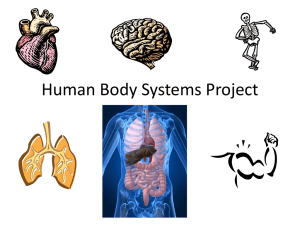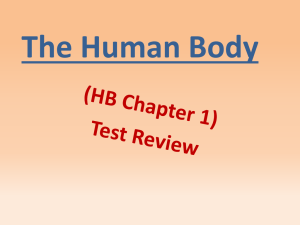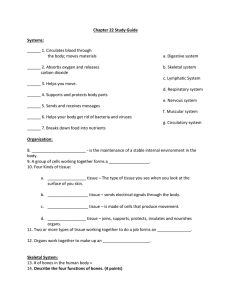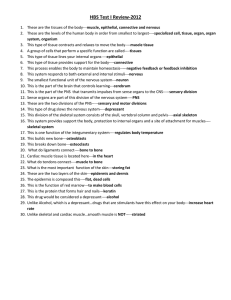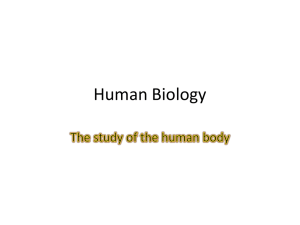Our Body Systems
advertisement
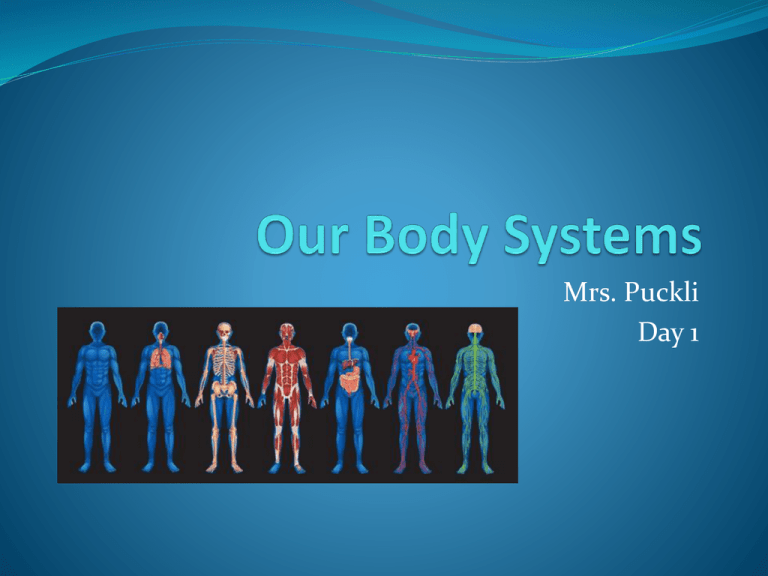
Mrs. Puckli Day 1 Bell Ringer! Welcome to Quarter Three Health with Mrs. Puckli!!! Take the Bell Ringer at the side table RESPIRATORY DIAGRAM and get started immediately upon entering! Respiratory System Organs that supply your blood with oxygen Mouth Nose Cilia –tiny hair like particles that line your nose and trap dirt and particles Trachea Lungs Diaphragm Parts of the Respiratory System Trachea- passageway in your throat that takes air into and out of your lungs Epiglottis- flap of tissue in the back of your mouth that keeps food out of your trachea (activity) Bronchi-two passageways that branch from the trachea, one to each lung Parts of the Respiratory System Lungs- two large organs that exchange oxygen and carbon dioxide Diaphragm- large, dome shaped muscle below the lungs. Expands and compresses the lungs-enabling breathing. Breathing Process Taking Care of your Respiratory System Avoid Tobacco use Stay away from people who smoke Take care of your body when you have the flu or respiratory illnesses Drink plenty of fluids Eat a healthful diet Be physically active on a regular basis Nervous System Body's control center Carries messages back and forth between your brain and all parts of your body SMELL, TOUCH, HEAR, TASTE, SEE Parts of the Nervous System 1. Central nervous system Brain Spinal Cord 2. Peripheral Nervous System Nerves that connect the central nervous system to all parts of the body Central Nervous System Brain- MOST important part Command center, coordinator, of the nervous system Spinal Cord Long bundle of neurons that sends messages to and from the brain and all parts of the body Activity with partner Taking Care of your Nervous System Eat nutritious foods Get enough rest Vaccinate against harmful diseases Protect yourself from physical injury Helmet, protective eyewear Lifting properly Follow traffic laws, wear seat -belt Journal Entry What do you think happens to food once you take a bite of something? Name the sequence of organs in the digestive system? Objective Identify Digestive, Circulatory, Muscular, and Skeletal systems in the body and their primary function List major components of these body systems Explain actions necessary to keep the body systems healthy Digestive System Group of organs that work together to break down foods into substances that your cells can use Where does it begin? Mouthtear and grind food with your teethSaliva Saliva-digestive juice produced by salivary glands in your mouth-moistens and softens food making it easier to swallow Amylase- enzyme in saliva that breaks down carbohydrates in food changing it from starch to sugar Enzyme-substance that aids in body's chemical reactions Digestive Organs Swallowesophogus Esophogus-contracts and relaxes and repeatedly moves the food along to the stomach Stomachchurn and mix the foodsmall intestine Small intestine- coiled tube from 20-23 ft long in which about 90 % of digestion takes place Food combines with enzymes and Villi, on the wall of the small intestine, take in nutrients from food Digestive Organs Small Intestinecolon (Large Intestine) Colon- tube 5-6 ft in length that plays a part in both digestion and excretion Last stop for solid food Caring for your Digestive System Eat balanced diet with low-fat, high fiber food Fiber helps system work properly Drink enough water-60-70% of your body weight is made up of water Keep teeth healthy Get regular physical activity-systems work better Circulatory System(cardiovascular system) A group of organs and tissues that act as a transfer station carrying needed material to cells and removing their waste products Heart- center of circulatory system Blood vessels Blood Cardio (heart)-vascular (blood vessels) system Circulation Path Pg 72 Caring for Circulatory System Make aerobic activity a habit-improves cardiovascular endurance Steps up the supply of oxygen and nutrients to your body Moderate-vigorous activity-helps cut the amount of fatty material in your blood Balanced food plan Manage stress-stress can strain your heart and blood vessels Avoid tobacco-nicotine narrows blood vessels-cutting down on oxygen supply Skeletal and Muscular Systems Skeletal- framework of bones and other tissues that supports the body Protects internal organs Helps us move 206 bones in the body Definitions Joints- places where two or more bones meet 1. Allow bones to move 2. Protect organs Tendons- type of connecting tissue that joins muscle to bones and muscle to muscle Achilles- attaches your calf to your heel bone Ligaments- type of connecting tissue that holds bones to other bones at the joint (knees and ankles) Cartilage- strong, flexible tissue that allows joints to move easily, cushions bones, and supports soft tissue Tip of your nose Knee joint Muscular System Tissue that moves parts of the body and control the organs Power and flexibility you need to move Skeletal Smooth Cardiac Skeletal Muscles Voluntary-you can control them Turning your head-brain sends the message to muscles in your neck Moving your arm Smooth Muscles Body’s organs Body’s blood vessels Involuntary- move without you consciously controlling their movement stomach Cardiac Muscle HEART involuntary Caring for your Bones and Muscles Stay physically active Flexibility exercises Stand up straight-proper posture keeps bones, joints, and muscles in the right place Lifting heavy objects-keep your back straight, bend your knees Eat healthy-muscles and bones get the right nutrients and food provides fuel for energy What nutrient can help build muscle?
